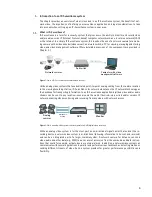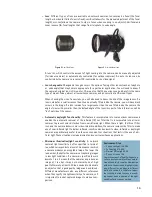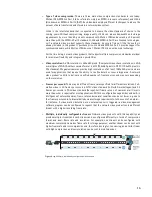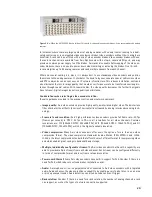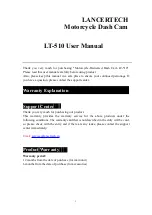
14
>
Lens
: Different types of lens are available on network cameras. Lenses may be fixed (the focal
length or horizontal field of view is fixed), varifocal (allows for the manual adjustment of the focal
length) or zoom (allows the camera to stay in focus when zooming in on objects). Varifocal and
zoom lenses offer focal lengths that range from telephoto to wide angle.
Figure 2.1.n.
Fixed lens
Figure 2.1.o.
Varifocal lens
A lens’ iris, which controls the amount of light coming into the camera, can be manually adjusted
(for indoor cameras) or automatically controlled (for outdoor cameras). An auto iris lens can be
controlled by the camera’s processor (DC-controlled), or by video signal.
>
Lens changeable
: Changeable lens gives users the option of using other lenses (such as telephoto
or wide angle) that may be more appropriate for a particular application. You will need to know if
the camera’s original lens is C-mount or CS-mount so that the new lens you purchase fits the same
type of mount. Today, almost all surveillance cameras and lenses sold are CS-mount types.
When choosing the size of a new lens, you will also need to know the size of the image sensor. If a
lens is made for a smaller sensor than the one actually fitted inside the camera, you will have black
corners in the image. If a lens is made for a larger sensor than the one fitted inside the camera, the
angle of view will be smaller than the default angle of the lens since part of the information will be
“lost” outside of the sensor.
>
Automatic day/night functionality
: This feature is incorporated into some outdoor cameras and
enables the automatic removal of the infrared (IR) cut filter that is incorporated into all color
cameras to prevent color distortion from near-infrared light. When there is light, the IR-cut filter
is on and the camera delivers color video. In dark conditions, the camera removes the filter to make
use of near-infrared light to deliver infrared-sensitive black and white video. Infrared or day/night
cameras are particularly useful in outdoor environments or situations that restrict the use of arti-
ficial light. These situations include discreet and covert surveillance applications.
>
Minimum illumination/light sensitivity
: A network
camera’s light sensitivity is often specified in terms of
lux, which corresponds to a level of illuminance in which
a camera produces an acceptable image. The lower the
lux number, the better the camera is at capturing images
in low light conditions. If a camera is specified to work
down to 1 lux, it means that the camera can produce an
image at 1 lux, but it may not necessarily be of high
quality. Normally, at least 200 lux is needed to illuminate
an object so that a good quality image can be obtained.
Different manufacturers also use different references
when they specify the lightsensitivity of a camera, so it
is important to look at captured images to make a com-
parison.
Environment: lux
> Strong sunlight: 100,000
> Full daylight: 10,000
> Normal office light: 500
> Poorly lit room: 100
Lux is the amount of light falling onto a
surface per square meter. Many natural
scenes have fairly complex illumination
with both shadows and highlights that
give different lux readings in different
parts of a scene. It is, therefore, impor-
tant to keep in mind that one lux read-
ing cannot be an indication of the light
condition for a scene as a whole.
Summary of Contents for IP-Surveillance system
Page 49: ...49 ...



